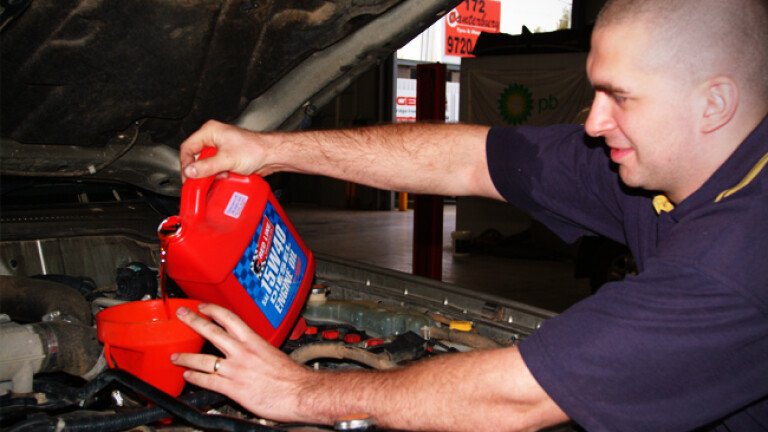
Red Line’s long-life engine oil really does work, and we’ve done the sampling to prove it.
I’ve finally changed the oil in my expedition Patrol … after 100,000km on the one fill!
“Holy mackerel,” I hear you say, “I don’t believe that!” Neither would I except I’ve done just that over the last three years and got the scientific oil sample reports to prove it. The end result was five times less engine wear over 100,000km (100K) than if I had changed my oil every 5000km with regular oil!
We changed our engine lubricant to Red Line fully synthetic, SAE 15W40 diesel engine oil some time ago. This oil is different again from most other synthetic oils on the market as Red Line contains polyol ester base stock; the only lubricant that can withstand the tremendous heat of modern jet engines.
The oil analysis report we got back is very comprehensive, with 22 minerals listed, along with measurements of soot, water, viscosity, oxidation, fuel dilution and much more.
I didn’t plan to go 100K. Initially I had my oil sampled every 10K, but as I gained more confidence, I increased it to 20K intervals. In the time I was doing the test, I also went from changing oil filters from every 10K to 20K.
Each time I changed oil filters (the Patrol having two main engine oil filters and an extra dunny-roll bypass filter as well) I had to replace 1.5-2.5 litres of lost oil.
Red Line oil is much more expensive to buy ($35-$40 a litre) and fill your engine with initially. However, compared to doing a mineral-oil change every 5K with filters at 10K, as recommended by the Nissan handbook, the break-even point is reached at around the 30K mark.
With such a big interval between oil changes, when you are travelling there’s no need to worry about when and where the next change is to be done. That’s a real plus when you are on holiday in this vast country of ours. I’d use Red Line for that reason alone!
We’ve included in the table below some of the most important criteria sampled during the test.
Iron is probably the biggest indicator of wear in an engine. Previously, with a high-quality mineral oil, the iron reading was 39 after just 5K. With Red Line we hadn’t even reached that after 21K!
Likewise, pentane insolubles (soot of a certain size) was 0.089 after 5K with a normal mineral oil, a figure not reached in 82K with Red Line.
The total base number (TBN) refers to the reserve alkalinity the oil has, which fights the acid formed by combustion, etc. The higher the starting number, the more reserve you start with, however, it is the rate of how quickly this number deteriorates over distance that is the most important.
In our case in the first 80K, the TBN varied between about seven and 12, and was just below three at the 100K mark, meaning it was still offering adequate protection against acid formation.
Red Line’s viscosity can rise 50 percent higher than the base number (the higher the number, the thicker the oil). As Red Line started at 14.5 it can perform up to 21.75 at which point the oil will need to be changed.
Red Line can easily handle TGA soot figures (a finer form of soot) above three percent and at the 80K mark was well under at 2.77 percent.
Pentane insolubles and TGA soot jumped between the 80K and 100K marks. This was caused more by me and my quest for more grunt than anything else and indicates the importance of proper tuning.
We had increased the fuel to the engine, which generates a lot more smoke (and power), but some of that smoke, or soot, ends up in the oil. Hence the jump in readings.
Since then I’ve had the boys at Outback 4WD turn the fuel down a notch and have decreased the smoke considerably (with minimal loss of power).
This, along with the TBN figure, was the main reason for changing the oil, but the Patrol is about to embark on another epic overseas adventure so a change was opportune.
Red Line says the oil-change interval can be around 20-25K for a diesel engine. This is a no-brainer recommendation that covers anyone and all engine types and operating conditions.
Still, Red Line has been interested in our testing, as traditionally 4X4s will contaminate oil faster than big trucks, which are the usual candidates for doing 100K on oil.
Since our 100K included every sort of travel condition, from hot, dusty days to cold wet and snowy ones, we have had the results correlated at both US and Australian labs. Basically, the Red Line oil performed its task with considerable ease.
Our expedition Patrol is still on Red Line and I’m so happy with the oil I’ve changed our Patrol wagon over to the same lubricant, but would I go out to 100K again? Short answer: No!
In both Patrols, I’ll be doing filter changes and the subsequent oil top-up every 20K. Then, around the 60-70K mark, I’ll change the oil completely. That’s a winner for me, my pocket, the vehicle and even the environment.
PRICE
$135 for 3.784L of 15W40 diesel engine oil
CONTACT: redlineoil.com.au, 08 9446 5041

COMMENTS